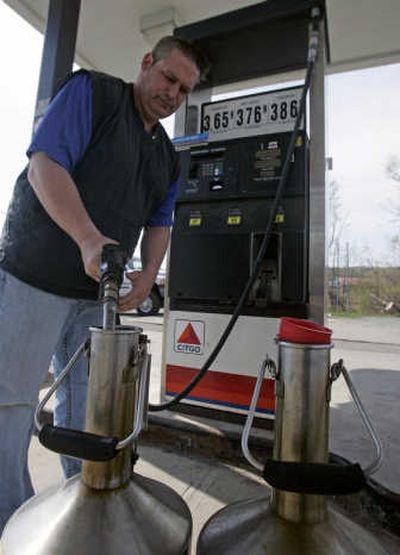Bad valves, high prices a double whammy

ALBANY, N.Y. – Angry about the price of gas? Just imagine paying for gas you don’t get.
Some alert consumers have noticed it over the years: A pump that seems to hesitate a second when the lever is squeezed. Anywhere from 2 to 6 cents tick off before the rush of gasoline starts. That’s what happens with a common, hard to diagnose and mostly ignored problem with the “check valve,” which is supposed to make sure gas flows at the same time the price meter starts.
But even if your gas pump works, it can still be off as much as $5 for every fill-up. Tests by local regulators allow a pump to charge as much as 6 cents more than the gas delivered in a five-gallon test, but there can be wild fluctuations. Federal regulators said they had heard of swings of 30 to 40 cents a gallon.
Don’t blame the gas guys. Even consumer advocates say retailers may be losing as often as consumers and no one appears able to rig the meters. But the small “check valve” at the end of the multibillion dollar industry just wears out and often goes unnoticed for months.
Regulators’ records show short staffing, particularly for financially struggling counties that try to inspect pumps every six months but too often don’t even meet the one-year requirement in states like New York.
Federal standards require all gas pumps to start delivering fuel as soon as the price meter starts, said Ken Butcher, of the National Institute of Standards of Technology, part of the U.S. Commerce Department.
Bob Wolfram knew something was wrong when the pump he used in Davenport, Iowa, showed he put two more gallons into his tank than the tank holds.
“I was low, but it wasn’t negative,” said Wolfram, a 54-year-old engineer.
He reported it to a consumer Web site and took it to government regulators, who acted promptly. But even then, the test showed the pump was off a quart.
Correcting the problem depends on alert, well-informed consumers like Wolfram. It also depends on honest retailers who choose to pass along reports to regulators who must confirm the problem before an authorized repair company is called to fix it.
“There’s one Mobil owner, he tells clerks that if there’s a discrepancy within $5 to reimburse the customer,” said C. Todd Godlewski, director of the Schenectady County Bureau of Weights and Measures in upstate New York, the agency that inspects pumps.
“Yes, it can be that much,” he said.
A bad valve can also work against retailers, freezing the price gauge for an instant after gas starts. No one’s sure who gets gored more, or how deeply.
“Even one penny on the amount of petroleum pumped annually or weekly at a station would be several thousand gallons of fuel, and add that up,” Godlewski said. “If you have a meter that is costing a customer, it adds up quite a bit.”
Bob Renkes, of the Petroleum Equipment Institute based in Tulsa, Okla., has heard about complaints, “mostly when gas prices are high.” He said meters “get looser over time,” which could make them malfunction and start to count pennies before fuel starts pumping.
“I think our industry would love to replace anything that wears down,” Renkes said. But the check valves aren’t a high priority when the industry is dealing with issues such as preventing identity theft when swipe cards are used, static electricity discharges and the 5 percent of retailers whose old mechanical equipment can’t register a price of $4 a gallon.
State and local regulators doubt any but the most ambitious consumers would contact them in case of a problem, even though the phone numbers are on inspection stickers. More likely, consumers fume and wonder if they were cheated, or report it to the manager of the gas station or convenience store.